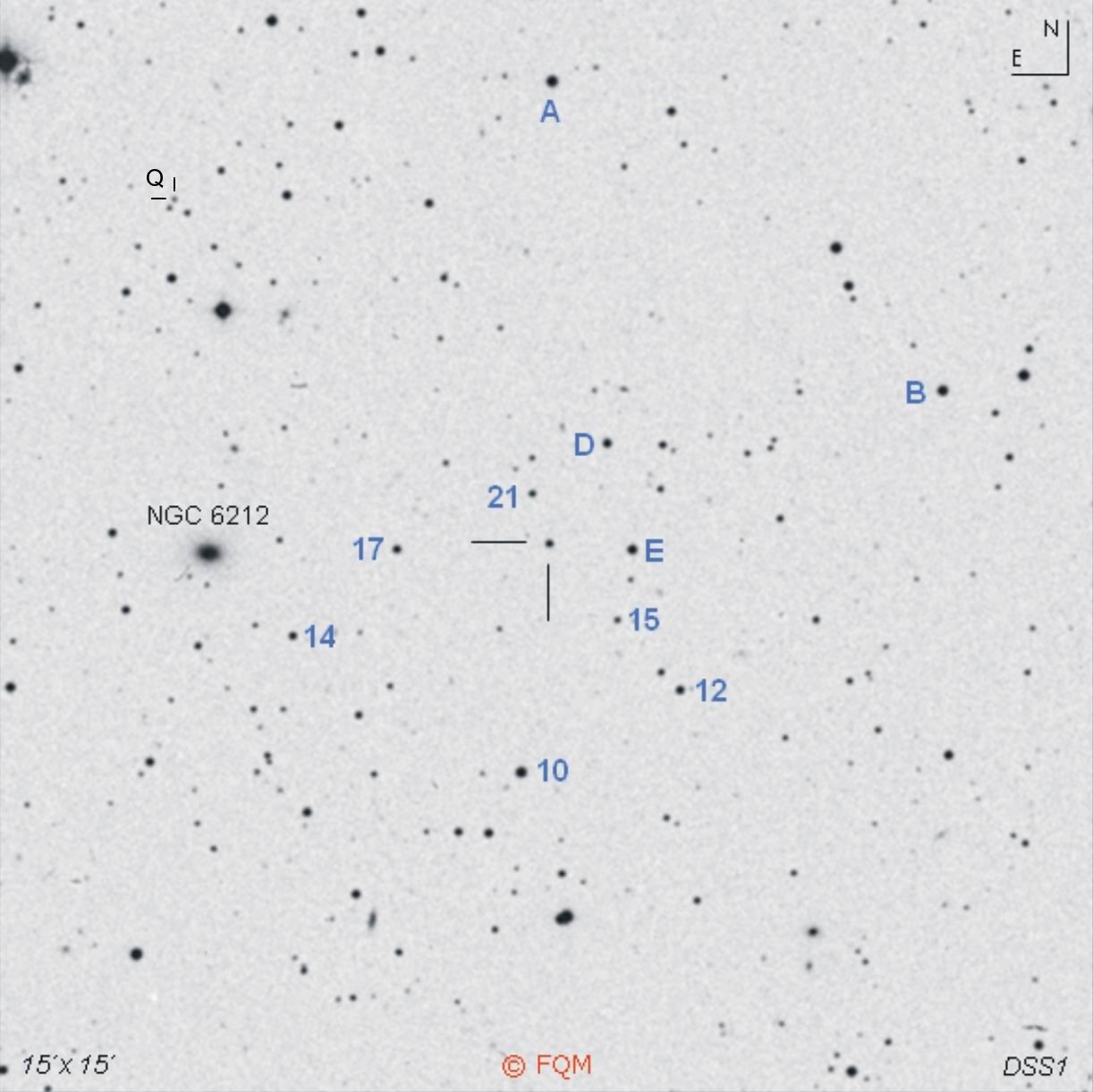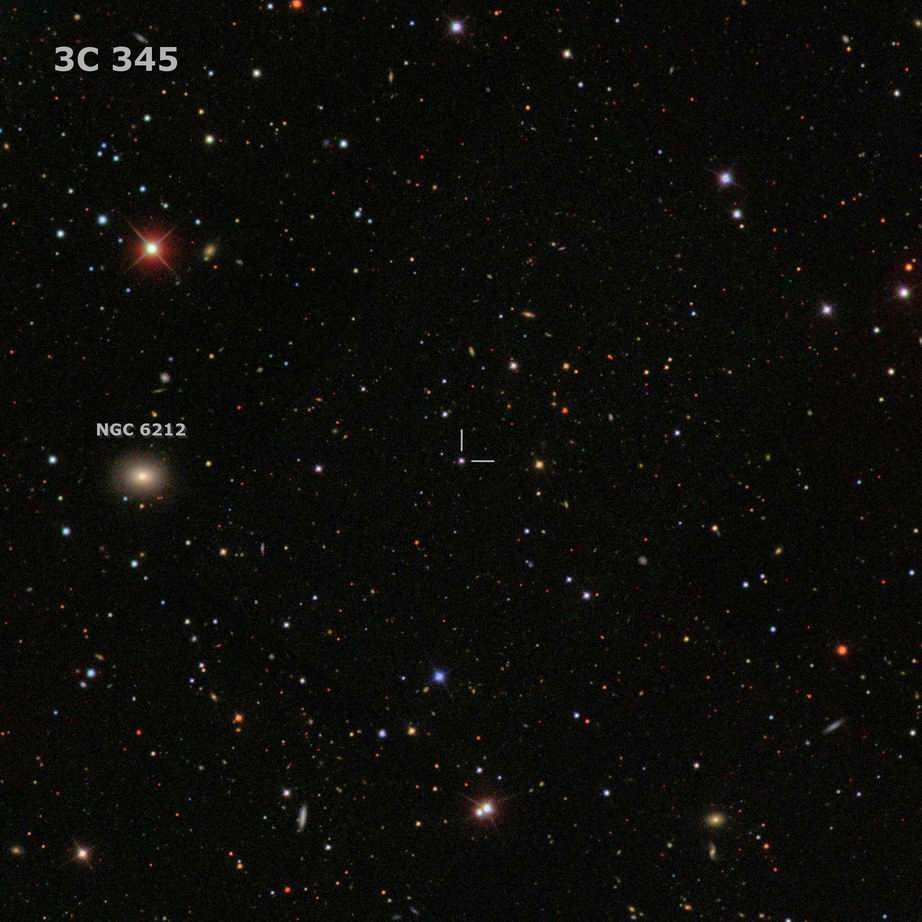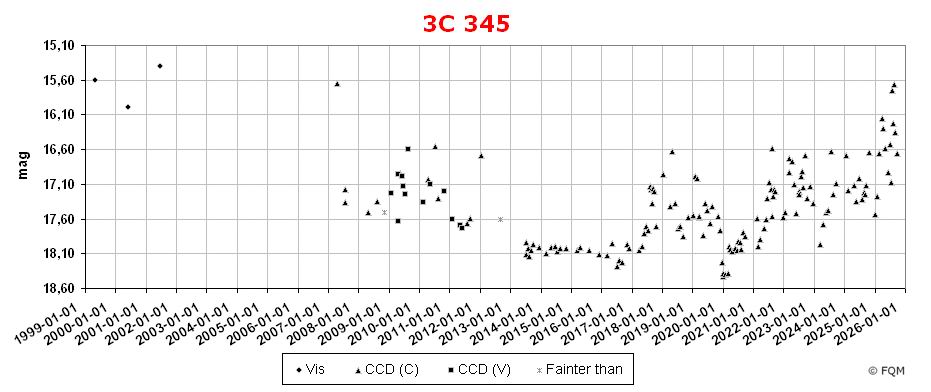
| Frankfurt Quasar Monitoring |
| 3C
345 |
| Cross-Identifications |
3C
345.0, B3 1641+399, 4C+39.48, S4 1641+39 TXS 1641+399, LEDA 97538, 1641+399, DA 240 WMAP J1642+3948, 2MASSi J1642587+394837 NRAO 513, LHE 413, OS+368, FBS 1641+399 RXS J164258.9+394822, IRAS 16413+3954A SDSS J164258.80+394837.0, 1ES 1641+399 87GB 164117.2+395405, RGB J1642+398 |
| Equat. coordinates | RA 16 42 58.8 DE +39 48 37 (J2000) |
| Constellation |
Hercules |
| Type | QSO |
| Redshift (1) (3) |
z=0.594 |
|
Distance
(2)
(4) |
2120 Mpc |
| Total mag range (mv) (5) | 14.5 - 18.37 |
| Catalog Magnitude (1) | 16.62 |
| Absolute Magnitude (1) | -25.9 MB |
| Light Travel-Time (2) | 5.493 × 109 yrs |

Comparison
stars
| star | B | V | R | I |
| A | 14.53 (0.05) | 13.86 (0.05) | 13.44 (0.03) | 13.08 (0.05) |
| B | 14.91 (0.07) | 14.26 (0.06) | 13.84 (0.05) | 13.49 (0.07) |
| D | 16.10 (0.06) | 15.22 (0.06) | 14.80 (0.05) | 14.37 (0.07) |
| E | 16.43 (0.09) | 15.17 (0.07) | 14.51 (0.04) | 13.86 (0.08) |
| 10 | 13.959 (0.012) | 13.773 (0.006) | 13.644 (0.010) | 13.491 (0.011) |
| 12 | 16.046 (0.008) | 15.418 (0.007) | 15.040 (0.009) | 14.669 (0.019) |
| 14 | 17.091 (0.020) | 16.083 (0.008) | 15.452 (0.014) | 14.900 (0.018) |
| 15 | 17.643 (0.031) | 17.134 (0.009) | 16.769 (0.005) | 16.405 (0.018) |
| 17 | 16.341 (0.037) | 15.701 (0.006) | 15.297 (0.008) | 14.912 (0.011) |
| 21 | 17.079 (0.021) | 16.508 (0.013) | 16.134 (0.013) | 15.781 (0.012) |



| 3C
345 is a violently variable quasar
in Hercules, only 53
arcmin N of 3.5-mag Eta (44) Herculis.
Quasar
3C 345 was discovered in 1959 as a bright radio source by the 3. Cambridge Radio Survey (3C). Since then, this quasar has been cataloged by several other radio surveys (e.g. 4C, B3, S4). In 1965, the new radio source was identified with a blue stellar object of 16.3 mag (phot.). Shortly after, the first redshift of z=0.594 was measured, which led to the classification as a quasar. A redshift of z=0.594 corresponds to a light travel time of nearly 5.5 Gyrs. As a blue stellar object it was also cataloged by the First Byurakan Spectral Sky Survey (FBS). 3C 345 soon became famous for its extreme variability in almost all wavelengths. In the optical, 3C 345 is very active with a total variability of 4 magnitudes. High resolution images obtained by the Hubble Space Telescope revealed the host galaxy of 3C 345. The images clearly showed an elliptical galaxy of type E3 (see image above), which was classified as a ultraluminous infrared galaxy (ULIRG). Besides the radio, optical and infrared, quasar 3C 345 has also been detected as an X-ray emitter. 3C 345 is a violently variable quasar with a total range of 4 magnitudes in the optical. A look at the light curve makes clear that quasar 3C 345 is a preferred target for CCD observers. Visual observers will only have a chance to glimpse this stellar object during the rare brighter states. Even with large instruments the quasar remains stellar. CCD observers as well as visual observers shall use the comparison stars given above. Another photometric sequence was published by Angione (1971). ____________
3C
345 is located
only 53 arcmin N of
3.5-mag Eta (44) Herculis,
which marks the upper right corner of the central square of Hercules. Visual
observers, who point their telescope to Hercules, will of course take a
stop for famous M13, the
"Great Hercules cluster", the brightest
globular cluster in the northern celestial hemisphere. M13 can be found
some
2.4° south of Eta Her, located at a distance of
25 000
light-years.
Under
dark skies, even a 4-inch telescope will resolve this globular.
Another bright globular worth visiting is M92, some 7°NE of 3C 345. Only 28´NE of M 13, we meet 12.1-mag galaxy NGC 6207, located at a distance of 46 million light-years. Spiral galaxy NGC 6207 is an easy task for 8-inch telescopes and larger. Only 4.6´E of 3C 345 another faint but interesting galaxy might attract the observers interest: NGC 6212 at a distance of 400 million light-years (see finding chart above). This faint compact elliptical harbours an AGN with Seyfert-1 spectrum, which is visible as a 15-mag point source at the galaxy centre. Stargazers who like to observers more very old quasi-stellar photons may turn to famous blazar MRK 501, a bright 13-mag object at a distance of about 440 million light-years, 2° E of 3C 345. Another very remote quasi-stellar object is PG 1718+481, a bright 14-mag quasar at a distance of nearly 8×109 light-years (!), some 10° NE of 3C 345. CCD observers might detect another faint quasar in their frames: This is 1WGA J1643.4+3953 = QSO B1641+3958 = SDSS J164326.14+395314.2, an 18.32 v-mag quasar with a redshift of z=0.704, only 7 arcmin NE of 3C 345 (see finding chart above, denoted by a small "Q" in the upper left corner). Quasar 1WGA J1643.4+3953 is also discernible as a faint bluish point source in the SDSS image above. |
| Angione, R.J. 1971, AJ, 76, 412; Photoelectric Sequences for the Brighter QSO´s. Barbieri, C., et al. 1968, MmSAI, 39, 421; Optical Monitoring of Quasi Stellar Objects at the Observatory of Asiago. Burbidge, E.M., Burbidge G.R. 1966, ApJ, 143, 271; Variations in the Optical Spectrum of the Quasi-stellar Radio Source 3C 345. Craine, E.R.; A Handbook of Quasistellar and BL Lacertae Objects; Parchart Publishing House, Tuscon 1977. Goldsmith, D.W., Kinman, T.D. 1965, ApJ, 142, 1693; The optical variability of 3C 345. Gonzŕlez-Pérez, J.N., et al. 2001, AJ, 122, 2055; Optical and Near-Infrared Calibration of AGN field stars: An All-Sky Network of faint stars calibrated on the Landolt System. Kidger, M., Takalo L. 1990, A&A, 239, L9; A large anti-flare in the light curve of 3C 345. Kirhakos, S., et al. 1999, ApJ, 520, 67; The Host Galaxies of three Radio-loud Quasars: 3C 48, 3C 345, and B2 1425+267. Lynds, C.R., Stockton, A.N., Livingston, W. C. 1965, ApJ, 142, 1667; New Spectroscope Observations of Quasi-Stellar Sources. Pollock, J.T., Pica A.J., Smith A.G., et al. 1979, AJ, 84, 11; Long-term optical variations of 20 violently variable extragalactic radio sources. Sandage, A., Wyndham J. 1965, ApJ, 141, 328; On the Optical Identification of eleven new Quasistellar Radiosources. Sandage, A. 1966, ApJ, 146, 13; The Correlation of Colors with Redshifts for QSS Leading to a Smoothed Mean Energy Distribution and New Values for the K-Correction. Schramm, K.-J., Borgeest, U., et al. 1993, A&A, 278, 391; Recent activity in the optical and radio lightcurves of the blazar 3C 345: indications for a 'lighthouse effect' due to jet rotation. Smith, P.S., Balonek, T.J., et al. 1985, AJ, 90, 1184; UBVRI Field Comparison Stars for Selected Active Quasars and BL Lacertae Objects. Steinicke, W.; Katalog heller Quasare und BL Lacertae Objekte; Umkirch 1998. Véron-Cetty, M.-P., Véron, P. 2001, A&A 374, 92; A Catalogue of Quasars and Active Nuclei: 10th edition. Véron-Cetty, M.-P., Véron, P. 2003, A&A 412, 399; A Catalogue of Quasars and Active Nuclei: 11th edition. Véron-Cetty, M.-P., Véron, P. 2006, A&A 455, 776; A Catalogue of Quasars and Active Nuclei: 12th edition. Véron-Cetty, M.-P., Véron, P. 2010, A&A 518, 10; A Catalogue of Quasars and Active Nuclei: 13th edition. Villata, M., Raiteri, C.M., et al. 1997, A&AS, 121, 119; Optical photometric monitoring of gamma-ray loud blazars. I. Wyndham, J.D. 1965, AJ, 70, 384; A Search for Optical Objects Associated with 50 Radio Sources. Wyndham, J.D. 1966, ApJ, 144, 459; Optical Identification of Radio Sources in the 3C Revised Catalogue. |
| Links: Landessternwarte Heidelberg Hamburg Quasar Monitoring Chara/PEGA VLBA GLAST Sloan Digital Sky Survey |
| home |